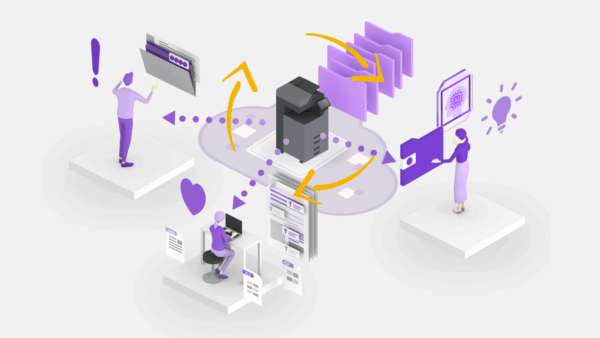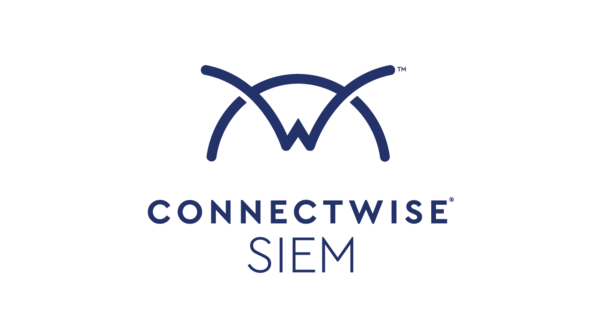As cybersecurity threats continue to evolve, office technology dealers and their customers face increasing concerns about the security of network-connected imaging devices. Once viewed as simple office tools, MFPs, copiers, and printers have become sophisticated network endpoints that process and store sensitive business data. This shift has made them prime targets for cyber criminals seeking unauthorized access to confidential information.
To combat these risks, office technology manufacturers have implemented advanced security measures to protect data, prevent unauthorized access, and ensure the integrity of their devices. These security innovations go beyond basic protections, incorporating cutting-edge technologies such as AI-driven threat detection, encryption, and secure authentication.
Device security isn’t a new phenomenon. Chris Markowski, director of portfolio management at Ricoh USA, references security concerns related to the old analog devices Ricoh was selling when he first started in the business in 1990. The transition to digital changed the security game. “The stakes were raised because now here’s an endpoint on the network that is really no different from the computers and the servers and everything else that everybody’s spending an awful lot of time securing,” recalled Markowski. “It’s a point of vulnerability and making sure that we are protecting a customer’s data as it comes into an organization, goes through the organization, and then goes out, is key to our overall security approach, which is a layered approach to look at all of those different areas.”
Stephen Uresk, senior vice president of technology at LDI Connect, credits HP’s Wolf campaign with raising customer awareness about device security, even if those customers weren’t frequently bringing security up during sales calls. “Post COVID, the world that is now in the cloud has created more concern about how secure the endpoints are because there’s more interaction between these devices and the outside world than before,” observed Uresk.
A Reseller Opportunity
Lexmark’s Chief Information Security Officer, Senior Director Bryan Willett, views device security as a key differentiator and an additional revenue opportunity. “Maybe it’s not what you lead with, but as an opportunity that should be inserted into the discussions of the deal,” he said.
He added that depending on who the dealer is selling to, the client’s maturity in securing, monitoring, and patching that device on a regular cadence may or may not be in their wheelhouse, especially with small and medium businesses. “I view that as an opportunity for the dealer to offer a service focused on security management and monitoring of a print fleet,” said Willett.
All device manufacturers offer security, so using the feature as a differentiator must be approached carefully. “For many companies, security is less of a differentiator and more table stakes,” opined Rob Pope, senior product manager for security products at Ricoh USA. “Instead of comparing us to the competition, we say, what are the customer’s requirements from a security standpoint, and can we meet those? Some of our largest customers have the strictest security requirements.”
Pope focuses exclusively on security, mainly from a device standpoint. “One hundred percent of the customers I deal with are talking about security,” said Pope, who acknowledged that’s not surprising because security is his primary role. “But there are concerns from every customer.”
He’s seen some significant changes during his tenure with Ricoh. “Ten years ago, nobody cared about the security of print jobs within their network,” said Pope. “Today, most of our strategic enterprise and larger global customers want their data encrypted even when it’s going across their internal network. So, the trends are changing as the times change.”
Ricoh encourages its dealers to talk to customers of any size about security. “If customers don’t bring up any particular concerns, maybe point out some areas where there could be concern without using scare tactics,” suggested Markowski. “Especially now with so much data and services available in the cloud. Once your data leaves your local environment, there’s an added layer of risk.”
“Obviously, over the past several years, there’s been a lot of data breaches and things in the news from some very high-profile companies,” said Pope. “I don’t think it’s even a question to walk into a customer and qualify them by saying, ‘Are you interested in keeping your information secure?’ That’s a stupid question nowadays. It should be, ‘How can we help you secure your data so that you don’t have to think about it?’”
“There’s no account that’s too small to present this to,” added LDI’s Uresk. “The clients with the least number of devices typically will have no IT management, or they’ll utilize third-party outsourced IT that will run vulnerability reports and then present them to us to remedy. This allows us to say, ‘Hey, in addition to providing copier services and managed print services, we can also provide you with a full managed IT service package and be that one throat to choke.’”
DSI in Albuquerque, New Mexico, has a well-rounded office technology product offering with devices from Konica Minolta, Sharp, Brother, and Epson. When asked if customers bring up device security, the dealership’s president, Jocelyn Gorman, replied, “Yes. Do they know what they’re talking about? No. So what we do is we use that as a selling approach.”
Multi-Layered Security and the Current Generation of Imaging Devices
Imaging device security extends across multiple layers, such as firmware, data storage, network communication, and user access. For example, HP equips its devices with HP Sure Start, a self-healing BIOS (basic input/output system) that prevents firmware tampering, and Run-Time Intrusion Detection, which continuously monitors for suspicious activity.
Similarly, Canon provides secure authentication and document protection, integrating user verification tools like Universal Login Manager to restrict access, and encryption features that ensure only authorized personnel can print documents.
Like most office technology manufacturers, security extends across the entire Ricoh product line, from A3 to A4 to production print. “We try to focus on it across the board because data is data,” said Pope. “The data doesn’t know whether it’s coming from or into what piece of equipment it is.”
Ricoh and Kyocera have also reinforced device security with encryption and data overwrite functions, safeguarding stored information and ensuring that sensitive data is completely erased when devices are decommissioned. Kyocera has also embraced a Zero Trust Security Model, requiring continuous user and device verification to prevent unauthorized access.
Sharp and Lexmark have embedded whitelisting technologies that prevent unauthorized applications from running on their devices. Sharp features Bitdefender Antivirus Integration, which continuously scans for malware threats, ensuring that network-connected devices do not become points of vulnerability.
Blockchain technology has also emerged as a promising security tool. Xerox, for example, uses blockchain-based solutions to authenticate documents and prevent unauthorized alterations. Xerox has integrated AI-powered analytics into its security strategy, enabling real-time monitoring and early detection of potential risks. With this AI-driven approach, devices identify abnormal usage patterns and automatically respond to threats before they escalate.
These developments reflect a broader industry trend of integrating advanced security technologies directly into office technology.
End-of-Life Security and Data Protection
A crucial, yet often overlooked, aspect of imaging device security is data disposal. MFP hard drives store vast amounts of sensitive information, making end-of-life security measures essential. Toshiba includes FIPS 140-2 validated self-encrypting drives in its devices, ensuring that stored data remains protected even if a device falls into the wrong hands.
Ricoh and Sharp, and to be inclusive, most manufacturers, offer secure end-of-lease data erasure features, which permanently remove all stored data before a device is decommissioned or resold. These measures give businesses peace of mind, knowing their confidential information won’t be left vulnerable after a device’s lifecycle ends.
Cloud Security and Secure Remote Management
As businesses increasingly shift toward cloud-based workflows, imaging device manufacturers have adapted by integrating enhanced cloud security features. Lexmark’s measures, for instance, ensure encrypted communication and secure remote management. Lexmark’s Secure by Design approach minimizes vulnerabilities with strict access controls and real-time intrusion detection.
“Anytime you move something to the cloud, your risk landscape grows rapidly,” observed Lexmark’s Willett. “The SSDL, the threat modeling, the CICD pipeline, and the tools we have built in the CICD pipeline using tools like cloud security, posture management, cloud workload protection platforms, and cloud identity, all mean you’re looking at identities and their access and making sure they’re not over-provisioned. Looking at threats within the environment. That’s another important part.”
Indeed, Lexmark security is a core element of its culture and business strategy, recognizing the importance of protecting its brand and customers. The company educates its employees on security risks and best practices and has implemented a secure software development lifecycle to make certain its products are safe by design. Lexmark also actively engages with the security research community, participating in events like Pwn2Own, a computer hacking competition, to stay ahead of emerging threats and vulnerabilities.
Similarly, Konica Minolta has prioritized remote fleet management security with its Shield Guard Technology, allowing IT administrators to monitor and manage security settings across multiple devices from a centralized dashboard. This capability is particularly valuable in hybrid work environments, where remote monitoring ensures that devices remain secure outside traditional offices.
Firmware security is another critical focus area for manufacturers such as Lexmark, with the company implementing measures to ensure only authentic firmware is installed on its devices. Lexmark also provides security logging and monitoring capabilities in its devices to help customers detect and respond to potential threats. However, when it comes to firmware, customers still need to step up. “The biggest risk is when customers do not update the firmware regularly,” revealed Willett, adding that many customers haven’t upgraded their firmware since the device was initially installed.
LDI Connect uses data from its managed print accounts to uncover sales opportunities tied to device security. The dealership uses FM Audit to track firmware levels across HP devices, identify outdated models, and assess where each device falls in the lifecycle—what can be upgraded or removed from service. That insight allows LDI to proactively recommend upgrades or enhanced services like firmware management, something larger accounts value so they can meet strict security policies.
“We need to pay attention to the trends in the security field, but also most definitely have to pay attention to the wants and needs of our customers,” said Pope. “If customers are looking for something and not finding it, whether it’s in our devices, then perhaps a middleware solution will help address it. We have an extensive portfolio of middleware and services available.”
Protecting Your Customer’s Data
For office technology dealers, being informed about these advancements is crucial. By educating customers on the security benefits of the imaging devices they sell, dealers can help businesses safeguard their data while differentiating themselves in a competitive market, at least from competitors who don’t market the security capabilities of the devices they sell.
The Dawn of Microsoft’s Windows Protected Print (WPP)
Microsoft Windows Protected Print (WPP) is a security feature designed to safeguard documents by preventing unauthorized access and tampering during the print process. WPP is part of Microsoft’s broader initiative to secure the print infrastructure in enterprise environments, particularly with Universal Print and Windows 11.
It ensures that print jobs are encrypted end-to-end, from the application that generates them to the printer itself, reducing the risk of data leakage during transit or at rest on the spooler. WPP can significantly improve an organization’s security audit posture, especially in environments bound by compliance frameworks, like HIPAA, GDPR, ISO 27001, etc.
WPP is an opportunity for office technology resellers to upgrade their customers’ print technology with WPP-compatible devices. Since WPP works best with Universal Print-native drivers, resellers can position devices with Universal Print support as essential hardware upgrades, especially for organizations moving to Windows 11 as version 10 sunsets this coming fall (see below).
Many printers today offer built-in security (e.g., HP SureStart, Canon Secure Print, Ricoh Always On). With WPP, resellers can frame these features as complementary layers, supporting zero-trust print environments.
End of Support for Windows 10
As of October 14, 2025, Microsoft will no longer provide free software updates, technical assistance, or security fixes for Windows 10. Is this a major deal or not? It could be.
Nobody likes having to deal with a new operating system (OS), points out Ray Vrabel, senior director of partner programs at ConnectWise. As summer edges closer, he anticipates “a big uproar, accompanied by whining and moaning.” Vrabel warns that threat actors will prey on systems that have not upgraded and are exposed. “There definitely is cybersecurity vulnerability associated with the Windows 10 ‘sunset,’” he said.
Jeremiah School, president of managed service provider DOT Security, sounded the Windows 10 alarm even more urgently. “Not budgeting for device upgrades is a sign of negligence,” contended School. DOT, a sister company to mega “non-dealer” Impact Networking (based in Lake Forest, Illinois), chooses a proactive approach.
“The whole Windows 10 to 11 thing is not a big deal, until it is a big deal,” School cautioned. If a rocky transition affects enough of its install base heading into 2026, Microsoft may release a security patch, as the tech giant has done in the past. “But do you want to take that risk?” he asked.





